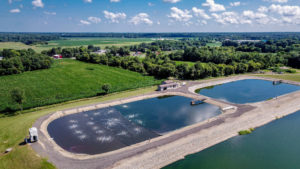 Virtually everything people consume or use ends up in the waste stream and ultimately back into the environment. A class of substances the EPA calls Contaminants of Emerging Concern, or CECs, has come under scrutiny in recent years to determine what types of chemicals are ending up in wastewater and how various wastewater treatment methods perform at removing them.
Virtually everything people consume or use ends up in the waste stream and ultimately back into the environment. A class of substances the EPA calls Contaminants of Emerging Concern, or CECs, has come under scrutiny in recent years to determine what types of chemicals are ending up in wastewater and how various wastewater treatment methods perform at removing them.
As it turns out, lagoons–especially aerated lagoons—matched or outperformed treatment plants at removing some of the most common wastewater CECs, like pharmaceuticals and personal care products. Read on for more about what types of contaminants end up in wastewater and what recent studies have shown about the efficiency of lagoons in removing them.
What are PPCPs?
PPCP is the catch-all abbreviation for Pharmaceuticals and Personal Care Products, the main source of CECs. Pharmaceuticals includes over-the-counter and prescription medications, both for humans and animals. Drug residues end up in wastewater after being ingested and excreted, or from unused drugs being flushed down the toilet. (This was the recommended disposal method for unused medications for many years—now the FDA suggests take-back programs or discarding in trash.) Personal care products are things like soap, shampoo, fragrances, cosmetics, and detergents, which are ultimately rinsed down the drain. The EPA states: “Because they dissolve easily and don’t evaporate at normal temperatures or pressure, PPCPs make their way into the soil and into aquatic environments via sewage, treated sewage sludge (biosolids), and irrigation with reclaimed water.”
Most of the attention paid to PPCPs in wastewater has centered around mechanical treatment plants, especially in urban areas. However, a few studies evaluating lagoon treatment specifically have demonstrated that lagoons do an adequate job removing most PPCPs and, for some compounds, outperform mechanical plants, and at much lower capital and operational costs.
Lagoons Do It Better
A study of the efficiency of PPCP removal in wastewater treatment conducted in Ontario, Canada, showed that lagoon treatment worked best at removing two of the most prevalent: triclosan and synthetic musks.
Triclosan is an antimicrobial and antifungal agent found in hand sanitizer, liquid hand soap, toothpaste, and shampoo. The most common antibacterial chemical used today, triclosan has come under scrutiny for being toxic to algae, as well as potentially leading to antibiotic resistance. Compared to conventional activated sludge (CAS) and CAS + filtration, lagoons performed best at removing triclosan.
The same study also found lagoons performed better at reducing levels of synthetic musks HHCB and AHTN—fragrances used in everything from cosmetics to laundry detergents—up to 99%, compared to as little as 37% in CAS systems.
A compilation of research published in the textbook Analysis, Removal, Effects and Risk of Pharmaceuticals in the Water Cycle: Occurrence and Transformation in the Environment outlines the efficiency of lagoon treatment in removing many PPCPs.
Aerated lagoons operated in series have shown to provide near-complete removal of the following common pharmaceuticals:
- Atenolol: Treats high blood pressure and heart disease
- Acetominiphen: Pain reliever (Tylenol®)
- Naproxen: NSAID anti-inflammatory pain reliever (Aleve®)
- Ibuprofen NSAID anti-inflammatory pain reliever (Advil®)
- Diphenhydramine: Antihistamine, sleep aid (Benadryl®, Unisom®)
- Sulfamethoxazole: Antibiotic (Bactrim®)
Aerated lagoons have also shown a removal efficiency of 99% for caffeine and cotinine, or metabolized nicotine.

A study published in Science of the Total Environment in 2013 looked specifically at the ability of aerated lagoon treatment to degrade PPCPs. Led by Wei Zheng, a senior research scientist at the Illinois Sustainable Technology Center and an adjunct faculty member in the University of Illinois Department of Natural Resources and Environmental Sciences, the study found the efficiency of a rural lagoon in PPCP removal relatively high, with the best performance in warmer seasons. Furthermore, no detectable steroid hormones were found in the lagoons or the effluent.
So far, the EPA hasn’t determined any harm to healthy humans from trace pharmaceuticals and personal care products in the environment. Studies of more sensitive people—such as pregnant women or the immunocompromised—and aquatic organisms continue. Early studies have shown disruption in the reproductive health of certain fish and mussels, so the possibility for harm to the health of waterways certainly exists. We can expect more scrutiny in coming years. In the meantime, it’s good to know that lagoons are performing at least as well as mechanical treatment plants in removing many of the most common PPCPs, and at a lower cost.
